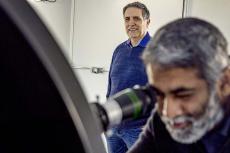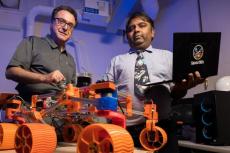Space Act Agreement With NASA Advances UA Engagement in Human Spaceflight
The University of Arizona recently signed a Space Act Agreement with NASA's Johnson Space Center that will allow the university to engage extensively in human spaceflight missions. The agreement will take the university's current association with NASA to a new level and foster joint research activities and technology transfer. Activities under the agreement will be pursued through university programs in various disciplines, including aerospace engineering, aeronautics, Earth and space science, radiation science and technology, human health and performance in space, and space materials.
"The University of Arizona is renowned for its space-related research and has participated in numerous NASA missions," said Elizabeth "Betsy" Cantwell, UA senior vice president for research and innovation.
The new agreement with the Johnson Space Center, the hub for human space travel, will allow the university to be substantially involved in human spaceflight expeditions, which is important at a time when spacefaring is being prioritized in the federal budget and national security priorities, Cantwell said.
Cantwell met with Vanessa E. Wyche, director of NASA's Johnson Space Center, in March to formally put the agreement into effect.
John O'Neil, UArizona vice president for research development, is the university’s point of contact for activities under the Space Act Agreement. He said that strengthening the university's partnership with NASA's Johnson Space Center is an important first step for supporting people in space.
"Human spaceflight has been a missing leg in the University of Arizona's comprehensive and enduring strategic relationship with NASA, and that is now being solved," O'Neil said.
Another outcome of the Space Act Agreement is that UA students will have unique opportunities to collaborate with NASA's best minds and participate in various educational outreach activities, such as mentorships and internships related to human spaceflight and the technical aspects of supporting humans in orbit and beyond. They will be exposed to the challenges of human spaceflight and the system-focused thinking required to solve those challenges to deliver the lowest risk profile for spaceflight activities.
"At NASA's Johnson Space Center, we are eager to meet the exciting challenges of the future exploration missions and keep the core capabilities of our center functional to accomplish the next generation of human spaceflights," said Johnson Space Center's Wyche. "This partnership will allow for collaboration in vital research, technology development initiatives and to build the student recruiting talent pipeline from the university to NASA."
There are many components of spaceflight, O'Neil said, adding that NASA has designed a new "super cool" spacesuit created for the Artemis III mission to the moon that will fit a variety of crew members and can accommodate over 90% of the male and female population in the U.S.
The agreement also allows for the exchange of technical information in a proprietary way, O'Neil said, and puts both UArizona and Johnson Space Center in a good spot for attracting more investment from government and commercial funding partners. In addition, university faculty members will be able to gain better insights into the academic needs of the aerospace industry.
The university's new Applied Research Building is home to state-of-the-art equipment that will support the development of more innovations in space exploration and advanced manufacturing.
Among many other cutting-edge features, the Applied Research Building has a thermal vacuum chamber that simulates environmental conditions in space and is the largest of its kind at any university in the world. The building also has a huge lab for evaluating the performance of objects ranging from airplane wings to sensors.



